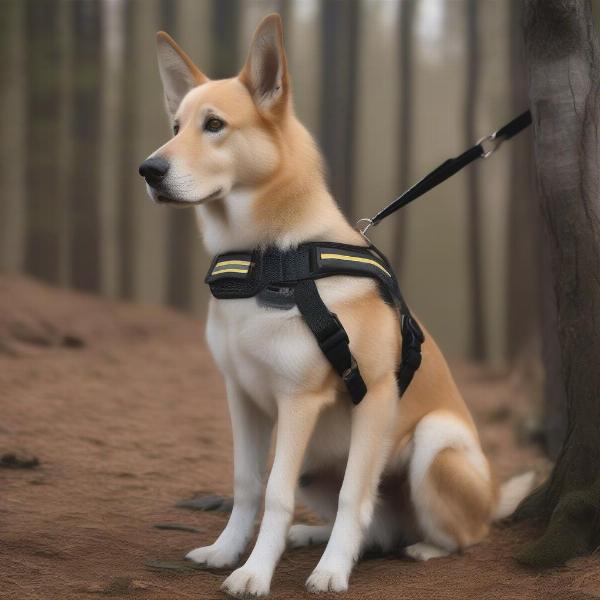A search and rescue dog harness is more than just a piece of equipment; it’s a lifeline, a vital tool that allows these brave canines to perform their life-saving duties effectively and safely. Whether your dog is a seasoned professional or just starting their search and rescue training, choosing the right harness is crucial for their comfort, performance, and overall well-being. This comprehensive guide will explore the essential features, types, and considerations for selecting the perfect search and rescue dog harness.
A well-fitted harness provides optimal support and weight distribution, crucial during rappelling, lifting, or carrying. The harness must also allow for a full range of motion, enabling the dog to navigate challenging terrain and perform their tasks efficiently. Durability is paramount, as the harness will be subjected to rigorous use and diverse environmental conditions. Finally, features like handles, attachment points, and reflective strips are essential for handler control and visibility in challenging situations.
Types of Search and Rescue Dog Harnesses
Several types of harnesses cater to the specific needs of search and rescue dogs. Understanding these differences will help you make an informed decision:
Tracking Harnesses
Designed for dogs specializing in tracking scents, these harnesses are typically lightweight and less restrictive, prioritizing mobility and comfort during long searches.
Rappelling Harnesses
These heavy-duty harnesses are built to withstand the forces of rappelling and feature multiple attachment points for secure rope systems and safety lines.
Multi-Purpose Harnesses
Combining features of tracking and rappelling harnesses, these versatile options offer a balance between mobility and strength, suitable for various search and rescue scenarios.
Key Features to Consider
Choosing the right harness involves considering several key features:
-
Fit: A properly fitted harness should be snug but not restrictive, allowing the dog to move freely without chafing or discomfort.
-
Material: Look for durable, weather-resistant materials like nylon or Cordura that can withstand harsh conditions.
-
Padding: Adequate padding in key areas like the chest and belly provides comfort and prevents pressure sores during extended wear.
-
Handles: Sturdy handles allow handlers to lift and assist the dog in challenging terrain or during rescue operations.
-
Attachment Points: Multiple attachment points provide versatility for different rope systems, safety lines, and other equipment.
-
Reflective Strips: High-visibility reflective strips ensure the dog is easily seen in low-light conditions.
 Key Features of a Search and Rescue Dog Harness
Key Features of a Search and Rescue Dog Harness
How to Fit a Search and Rescue Dog Harness
Proper fit is essential for both comfort and safety. Follow these steps to ensure a perfect fit:
-
Measure your dog: Take accurate measurements of your dog’s girth, chest, and neck to determine the correct harness size.
-
Adjust the straps: Adjust the straps to ensure a snug fit without restricting movement. You should be able to fit two fingers between the harness and your dog’s body.
-
Check for chafing: Ensure there are no areas where the harness rubs or chafes against the dog’s skin.
-
Test the harness: Take your dog for a short walk with the harness on to observe their movement and comfort level.
Conclusion
Choosing the right search and rescue dog harness is a crucial investment in your dog’s safety and performance. By considering the type of work your dog will be doing, the key features outlined above, and ensuring a proper fit, you can equip your canine partner with the essential gear they need to succeed. A well-chosen harness will contribute to their comfort, efficiency, and overall effectiveness in their life-saving missions. Remember to regularly inspect the harness for wear and tear and replace it as needed.
FAQ
-
What is the best material for a search and rescue dog harness? Durable, weather-resistant materials like nylon or Cordura are ideal.
-
How often should I replace my dog’s harness? Replace the harness as soon as it shows signs of wear and tear or damage.
-
Can I use a regular dog harness for search and rescue? No, regular dog harnesses are not designed for the specific demands of search and rescue work.
-
How do I know if the harness fits my dog correctly? The harness should be snug but not restrictive, allowing for two fingers to fit between the harness and the dog’s body.
-
Where can I buy a search and rescue dog harness? Specialized pet supply stores or online retailers specializing in tactical gear often carry search and rescue dog harnesses.
-
Are there harnesses specifically designed for water rescues? Yes, some harnesses are designed with flotation and quick-release buckles for water rescues.
ILM Dog is a leading international pet website dedicated to providing expert advice on all aspects of dog care and wellbeing. From breed selection to health, training, nutrition, and grooming, we offer a wealth of reliable and practical information for dog owners worldwide. Whether you’re a seasoned dog owner or just starting out, ILM Dog is your trusted source for all your canine needs. Learn more about our services at dogs lost cornwall and free to good home dogs. Contact us at [email protected] or +44 20-3965-8624. ILM Dog – Your Partner in Dog Care.